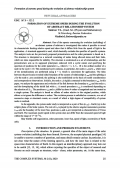The evolution (unfolding) of a number of characteristics in an abstract system of relations is investigated depending on the change in its maximum scale factor, which allows the dependence of the Sun burning on the eccentricity of the Earth orbit to represent using an application. A structural approach is used, which basically excludes the specifics of specific systems. The analysis tool is a protostructure, while the structure is understood as a set of relations, and the protostructure appears as its supposed primary basis. It consists of two components, endowed with cyclic nature, and specifies the spectrum of positions of the order parameter n k , where k is an ordinal number of a node being an allowed state in the selected cycle k = 1 - 10. All normalizations are performed for the k = 3, which is convenient for the application. Earlier, for the node k = 3, we obtained model positions Δ 3 at different stages of evolution, where Δ 3 is the splitting of the position n 3 as a result of its interaction with other n-positions in the system of nodes k = 1-10. To compare the nodes in the named system, scale factors are proposed, of which the largest is selected. It is also shown that as a result of the interaction between the protostructure components, the system boundary n min is formed, on which, on the one hand, the limiting velocity υ max / υ 3, and on the other, the splitting of the position n 3 , Δ 3, depend. The indicated speed is understood as an invariant and corresponds to the speed of light within δ = 1 * 10 -5 %. This paper analyses M / m 3, which is the largest scale factor of the system called the key one; it decreases in the process of evolution and plays the role of a control parameter, on which all other characteristics depend, except for the invariant υ max / υ 3. The following values are suggested for M / m3: a) initial value; b) the value at which the splitting Δ 3 appears, and c) the relationships of the above characteristics. Being based on this, and taking into account the backstory, a disc






